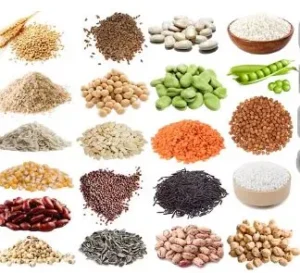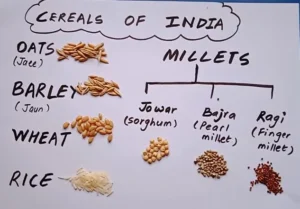Cereals and Millets Magic: Discover the Secret Superfoods You’ve Been Missing
Benefits of Incorporating Cereals and Millets into Your Diet
Including cereals and millets in your daily diet offers a plethora of health benefits. These nutrient-dense grains are packed with essential vitamins, minerals, and dietary fiber that contribute to overall well-being. By incorporating a variety of cereals and millets into your meals, you can enhance your immune system, support digestion, and maintain optimal energy levels throughout the day.
Moreover, cereals and millets are a great source of complex carbohydrates that provide a sustained release of energy, making them an ideal choice for maintaining steady blood sugar levels. Their high fiber content aids in promoting satiety, which can be beneficial for weight management goals. Regular consumption of it can also help lower cholesterol levels and reduce the risk of chronic diseases such as diabetes and cardiovascular issues.
Understanding the Nutritional Value of Cereals and Millets
Cereals and millets are renowned for their exceptional nutritional value, making them essential components of a healthy diet. These grains are rich in complex carbohydrates, dietary fiber, vitamins, and minerals, offering a potent source of energy and nutrients. Their high fiber content aids in digestion, promotes satiety, and helps in regulating blood sugar levels, making them ideal choices for individuals aiming to maintain a balanced diet.
Furthermore, It boast a diverse nutrient profile that includes essential vitamins like B-complex vitamins, vitamin E, and minerals such as iron, magnesium, and phosphorus. These nutrients play crucial roles in supporting overall health, including energy metabolism, immune function, and bone health. Incorporating a variety of cereals and millets into your diet can contribute significantly to meeting your daily nutrient requirements and promoting optimal well-being.
Exploring Different Types of Cereals and Millets
Sorghum, a gluten-free grain, is a versatile cereal that can be ground into flour for baking or popped like popcorn as a snack. Its mild flavor makes it a popular choice in various dishes worldwide. Amaranth, known for its high protein content, is often used in soups, stews, and porridges. This pseudo-grain is praised for its nutty flavor and impressive nutritional profile, making it a staple in many cuisines.
Moving on to millets, we encounter a diverse group of small-seeded grasses that are gluten-free and rich in nutrients. Foxtail millet, commonly used in Indian cuisine, is a good source of fiber and protein. Pearl millet, popular in African and Asian regions, is a nutritious grain that thrives in arid environments. These varieties of cereals and millets offer a wide range of textures and flavors to elevate the culinary experience while providing essential nutrients for a balanced diet.
• Sorghum, a gluten-free grain, can be ground into flour for baking or popped like popcorn
• Amaranth, high in protein, is often used in soups, stews, and porridges
• Millets are small-seeded grasses that are gluten-free and nutrient-rich
• Foxtail millet is a good source of fiber and protein commonly used in Indian cuisine
• Pearl millet is popular in African and Asian regions for its nutritional benefits
Tips for Cooking with Cereals and Millets
To truly harness the nutritional benefits of cereals and millets in your meals, it is essential to be mindful of the cooking methods employed. When cooking with cereals and millets, ensure to thoroughly rinse them before use in order to remove any impurities or residues. This step not only enhances the taste of the final dish but also helps in improving their digestibility.
Experimenting with different cooking techniques such as boiling, steaming, or even toasting can bring out diverse flavors and textures from cereals and millets. Utilizing broth or stock instead of water while cooking can infuse an added layer of flavor, resulting in a more appetizing dish. Endeavor to follow the recommended cooking times for each type of cereal or millet to achieve the desired consistency and ensure optimal nutrient retention.
Health Benefits of Consuming Cereals and Millets Regularly
One of the key advantages of regularly incorporating cereals and millets into your diet is their rich nutrient content. These grains are excellent sources of essential vitamins, minerals, and dietary fiber, which are crucial for maintaining overall health and well-being. Including a variety of cereals and millets in your meals can help improve digestion, regulate blood sugar levels, and support a healthy immune system.
Furthermore, consuming cereals and millets regularly can aid in reducing the risk of chronic diseases such as heart disease, diabetes, and certain types of cancer. These grains have been linked to lower cholesterol levels and improved cardiovascular health due to their high fiber content and beneficial nutrients. By choosing to include It in your diet, you are not only promoting your own health but also taking a significant step towards disease prevention and management.
Incorporating Cereals and Millets into Your Meal Planning
When it comes to incorporating cereals and millets into your meal planning, it is essential to diversify your choices to reap the maximum nutritional benefits. Start by exploring a variety of cereals and millets such as quinoa, amaranth, bulgur, and sorghum to add not only different flavors but also a wide range of nutrients to your meals. Experiment with these grains in different recipes like salads, soups, casseroles, and even in breakfast options to keep your meals interesting and healthy.
Additionally, consider meal prepping with cereals and millets to save time during the week. Cook a big batch of your favorite grains and store them in the fridge to easily add them to salads or warm them up as a side dish. Planning ahead and incorporating these versatile grains into your meal prep routine can help you stay on track with your healthy eating goals while enjoying delicious and nutritious meals.
The Environmental Impact of Choosing Cereals and Millets
Choosing cereals and millets as staples in your diet can have a positive impact on the environment. These crops are often hardier and require fewer resources such as water and fertilizers compared to other grains like rice or wheat. By opting for cereals and millets, you are supporting more sustainable agricultural practices that promote biodiversity and reduce the carbon footprint of food production.
Additionally, the cultivation of cereals and millets can help in soil conservation and prevent land degradation. These crops have deep rooting systems that help improve soil structure and fertility, making them ideal for sustainable farming methods. By incorporating cereals and millets into your diet, you are contributing to a more environmentally-friendly food system that prioritizes both human health and the well-being of the planet.
How Cereals and Millets Can Help in Weight Management
When it comes to managing weight effectively, incorporating cereals and millets into your diet can be highly beneficial. These whole grains are rich in dietary fiber, which helps in promoting a feeling of fullness and satiety, thereby reducing overall caloric intake. Additionally, the complex carbohydrates present in it are slowly digested, leading to a steady release of energy and preventing spikes in blood sugar levels, which can help in controlling cravings and overeating.
Furthermore, cereals and millets are nutrient-dense foods that provide essential vitamins, minerals, and antioxidants that support overall health and well-being. By replacing refined grains with whole grains like quinoa, amaranth, or sorghum, individuals can boost their nutrient intake while managing their weight more effectively. These nutritious grains can be a versatile and satisfying addition to meals, offering a variety of textures and flavors that can enhance the overall eating experience while supporting weight management goals.
Addressing Common Misconceptions About Cereals and Millets
Common misconceptions about it often stem from a lack of understanding of their nutritional value. Some believe that these grains are only meant for livestock consumption or lack essential nutrients required for human health. However, they are in fact rich in fiber, vitamins, minerals, and antioxidants that can contribute significantly to a balanced diet. These grains offer a variety of health benefits, such as aiding digestion, regulating blood sugar levels, and reducing the risk of chronic diseases.
Another misconception is that they are bland or unappetizing, which may deter individuals from incorporating them into their meals. Contrary to this belief, these grains can be incredibly versatile and flavorful when prepared creatively. With various cooking methods and accompanying ingredients, cereals and millets can be turned into delicious dishes that cater to different tastes and preferences. By debunking these misconceptions and exploring the culinary possibilities of it, individuals can enjoy the nutritional benefits and diverse flavors that these grains have to offer.
Exploring Global Cuisines That Feature Cereals and Millets
Millet, a staple crop in many African and Asian countries, is widely used in various global cuisines. In India, dishes like dosa and idli are made from ground millet flour, while in Africa, millet porridge is a popular breakfast choice. The versatility of millet allows it to be incorporated into both sweet and savory dishes, making it a favorite ingredient in many culinary traditions.
Quinoa, although technically a seed, is often included in discussions about grains due to its similar culinary uses. Originating from South America, quinoa has gained popularity worldwide for its high protein content and nutty flavor. In dishes like Peruvian quinoa soup and Bolivian quinoa salad, this pseudo-cereal adds both nutrition and taste, showcasing how global cuisines embrace diverse ingredients to create delicious and wholesome meals.
What are some common types of cereals and millets that can be incorporated into your diet?
Some common types of cereals and millets include rice, wheat, corn, barley, oats, quinoa, millet, and sorghum.
What are the health benefits of consuming cereals and millets regularly?
Consuming cereals and millets regularly can help improve digestion, provide essential nutrients like fiber and vitamins, regulate blood sugar levels, and promote overall heart health.
How can I incorporate cereals and millets into my meal planning?
You can incorporate cereals and millets into your meal planning by using them as a base for meals like salads, stir-fries, soups, and grain bowls, or incorporating them into baked goods like muffins or bread.
What is the environmental impact of choosing cereals and millets over other food options?
Choosing it over other food options can have a lower environmental impact as they require less water, land, and resources to grow compared to animal-based products.
Can cereals and millets help with weight management?
Yes, cereals and millets can help with weight management as they are high in fiber, which can help you feel full for longer periods of time and prevent overeating.
Are there any common misconceptions about cereals and millets?
One common misconception about cereals and millets is that they are bland or boring, but with the right spices and cooking techniques, they can be delicious and versatile ingredients in a variety of dishes.
How can I explore global cuisines that feature cereals and millets?
You can explore global cuisines that feature cereals and millets by trying out recipes from different cultures, visiting international restaurants, or joining cooking classes that focus on traditional dishes using cereals and millets.
You Can read this too


